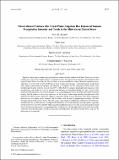| dc.contributor.author | Fan, Ying | |
| dc.contributor.author | Lintner, Benjamin R. | |
| dc.contributor.author | Weaver, Christopher P. | |
| dc.contributor.author | Alter, Ross Evan | |
| dc.date.accessioned | 2016-03-02T01:39:36Z | |
| dc.date.available | 2016-03-02T01:39:36Z | |
| dc.date.issued | 2015-08 | |
| dc.date.submitted | 2014-12 | |
| dc.identifier.issn | 1525-755X | |
| dc.identifier.issn | 1525-7541 | |
| dc.identifier.uri | http://hdl.handle.net/1721.1/101392 | |
| dc.description.abstract | Significant increases in summer precipitation have occurred in the midwestern United States over the last century for reasons that remain unclear. It is postulated that the expansion of irrigation and cropland in the central United States over the past 60 yr has been a major contributor to these observed increases in precipitation. As a first step toward attribution of these precipitation changes, a detailed analysis of observed daily summer precipitation frequency and intensity is conducted for the contiguous United States over multiple spatial scales and time periods from 1895 to 2011. Robust increases in precipitation frequency, total precipitation, and moderate to heavy precipitation intensity are identified during July and August in the midwestern United States. Analysis of changes in mean monthly precipitation from the early to late twentieth century initially points to increasing frequency as the source of increasing monthly precipitation in the midwestern United States during the summer, especially during August; however, these large frequency increases are not unique to the summer. On the other hand, changes in precipitation intensity and total precipitation are both greatest during July and August and coincide spatially in the midwestern United States. Additionally, the greatest intensity change occurs downwind of the most heavily irrigated regions, especially for the period between 1950 and 1980 when irrigation rapidly intensified. Thus, the seasonality and location of these regional signatures of increasing precipitation intensity (and total precipitation) are found to be broadly consistent with spatiotemporal trends in irrigation and cropland in the central United States and may be indicative of a causal link. | en_US |
| dc.description.sponsorship | United States. Environmental Protection Agency (EPA-STAR-RD834190) | en_US |
| dc.description.sponsorship | American Meteorological Association (AMS/Industry/Government Graduate Fellowship) | en_US |
| dc.description.sponsorship | National Science Foundation (U.S.) (NSF-AGS-1045110) | en_US |
| dc.language.iso | en_US | |
| dc.publisher | American Meteorological Society | en_US |
| dc.relation.isversionof | http://dx.doi.org/10.1175/jhm-d-14-0115.1 | en_US |
| dc.rights | Article is made available in accordance with the publisher's policy and may be subject to US copyright law. Please refer to the publisher's site for terms of use. | en_US |
| dc.source | American Meteorological Society | en_US |
| dc.title | Observational Evidence that Great Plains Irrigation Has Enhanced Summer Precipitation Intensity and Totals in the Midwestern United States | en_US |
| dc.type | Article | en_US |
| dc.identifier.citation | Alter, Ross E., Ying Fan, Benjamin R. Lintner, and Christopher P. Weaver. “Observational Evidence That Great Plains Irrigation Has Enhanced Summer Precipitation Intensity and Totals in the Midwestern United States.” Journal of Hydrometeorology 16, no. 4 (August 2015): 1717–1735. © 2015 American Meteorological Society | en_US |
| dc.contributor.department | Massachusetts Institute of Technology. Department of Civil and Environmental Engineering | en_US |
| dc.contributor.mitauthor | Alter, Ross Evan | en_US |
| dc.relation.journal | Journal of Hydrometeorology | en_US |
| dc.eprint.version | Final published version | en_US |
| dc.type.uri | http://purl.org/eprint/type/JournalArticle | en_US |
| eprint.status | http://purl.org/eprint/status/PeerReviewed | en_US |
| dspace.orderedauthors | Alter, Ross E.; Fan, Ying; Lintner, Benjamin R.; Weaver, Christopher P. | en_US |
| dc.identifier.orcid | https://orcid.org/0000-0003-3730-4641 | |
| mit.license | PUBLISHER_POLICY | en_US |
| mit.metadata.status | Complete | |
